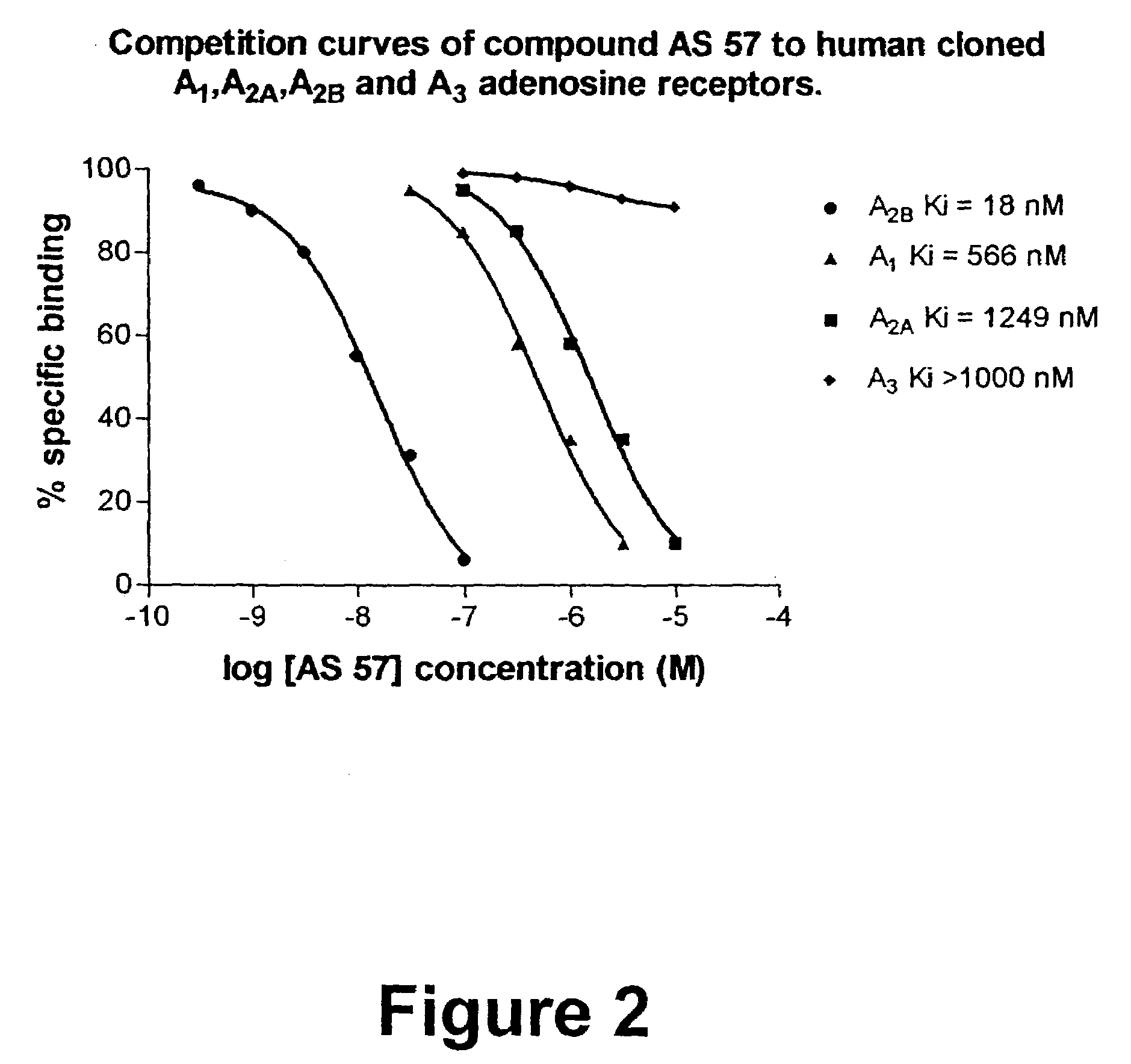8-Heteroaryl xanthine adenosine A2B receptor antagonists
a technology of adenosine a2b and receptor, which is applied in the field of compounds having antagonistic activity on adenosine a2b receptors, can solve the problems of unsatisfactory side effects, many questions about the patho-physiological role of asub>2b /sub>receptors have not yet been answered, and its use is associated with unpleasant side effects
- Summary
- Abstract
- Description
- Claims
- Application Information
AI Technical Summary
Benefits of technology
Problems solved by technology
Method used
Image
Examples
example 1
Preparation of Compound AS3
[0138]
[0139]A solution of 1,3-dipropyl-5,6-diaminouracil (0.7 g, 0.003 mol), 1-methyl-3-(benzyloxycarbonylamino)-pyrazole-5-carboxylic acid (0.8 g, 0.003 mol), and EDCl (0.6 g, 0.003 mol) in 50 mL of CH3OH was stirred at room temperature for two hours. Excess CH3OH was evaporated in vacuo to give a yellow solid that was collected by filtration and washed with H2O to give the amide intermediate.
[0140]A mixture of the amide intermediate and 30 mL of 2.5 N NaOH was warmed to 70–80° C. for three hours. The clear aqueous solution was cooled and acidified to pH 5 with concentrated HCl. The white precipitate that formed was collected by filtration and washed with H2O to afford the desired 1,3-dipropyl-8-(3-amino-1-methylpyrazol-5-yl)xanthine, which was recrystallized from CH3OH.
[0141]MP: 285–288° C.; 1H-NMR (DMSO-d6): δ 0.93 (m, 6H), 1.58 (m, 2H), 1.75 (m, 2H), 3.88 (bs, 2H), 4.01 (s, 5H), 6.21 (s, 1H), 13.51 (bs, 1H).
example 2
Preparation of Compound AS11
[0142]
[0143]A solution of phenylacetic acid (0.196 mmol) in 3 mL of thionyl chloride was stirred at 70° C. for four hours, then excess thionyl chloride removed in a nitrogen stream. A solution of 1,3-dipropyl-8-(3-amino-1-methylpyrazol-5-yl)xanthine (0.151 mmol, Example 1) and 0.04 mL of anhydrous triethylamine in 10 mL of CH2Cl2: CH3OH (1:1) was added and the mixture was stirred at room temperature for 24 hours, monitoring by TLC.
[0144]At completion, the solvent was evaporated, the residue dissolved in ethyl acetate, and the solution washed with saturated aqueous NaHCO3 and brine. The organic layer was dried (Na2SO4), filtered, and evaporated in vacuo. The desired product was purified by column chromatography on silica gel.
[0145]MP: 139–140° C.; 1H-NMR (DMSO-d6): δ 0.89 (q, 6H, J=5.18 Hz), 1.59 (q, 2H, J=7.18 Hz), 1.72 (q, 2H, J=7.06 Hz), 3.62 (s, 2H), 3.88 (t, 2H, J=6.72 Hz), 3.98 (t, 2H, J=6.96 Hz), 4.12 (s, 3H), 7.25–7.33 (m, 6H), 10.8 (s, 1H), 14.02 ...
example 3
Preparation of Compound AS12
[0146]
[0147]Using 2,4-dichlorophenoxyacetic acid and 1,3-dipropyl-8-(3-amino-1-methylpyrazol-5-yl)xanthine (Example 1, Compound AS3).
[0148]MP: 225–226° C.; 1H-NMR (DMSO-d6): δ 0.85 (m, 6H), 1.59 (m, 2H), 1.72 (m, 2H), 3.85 (t, 2H), 4.01 (t, 2H), 4.14 (s, 3H), 4.87 (s, 2H), 7.10 (d, 1H), 7.33 (m, 2H), 7.60 (d, 1H), 10.80 (s, 1H), 14.02 (s, 1H).
PUM
| Property | Measurement | Unit |
|---|---|---|
| temperature | aaaaa | aaaaa |
| temperature | aaaaa | aaaaa |
| temperatures | aaaaa | aaaaa |
Abstract
Description
Claims
Application Information
 Login to View More
Login to View More - R&D
- Intellectual Property
- Life Sciences
- Materials
- Tech Scout
- Unparalleled Data Quality
- Higher Quality Content
- 60% Fewer Hallucinations
Browse by: Latest US Patents, China's latest patents, Technical Efficacy Thesaurus, Application Domain, Technology Topic, Popular Technical Reports.
© 2025 PatSnap. All rights reserved.Legal|Privacy policy|Modern Slavery Act Transparency Statement|Sitemap|About US| Contact US: help@patsnap.com



